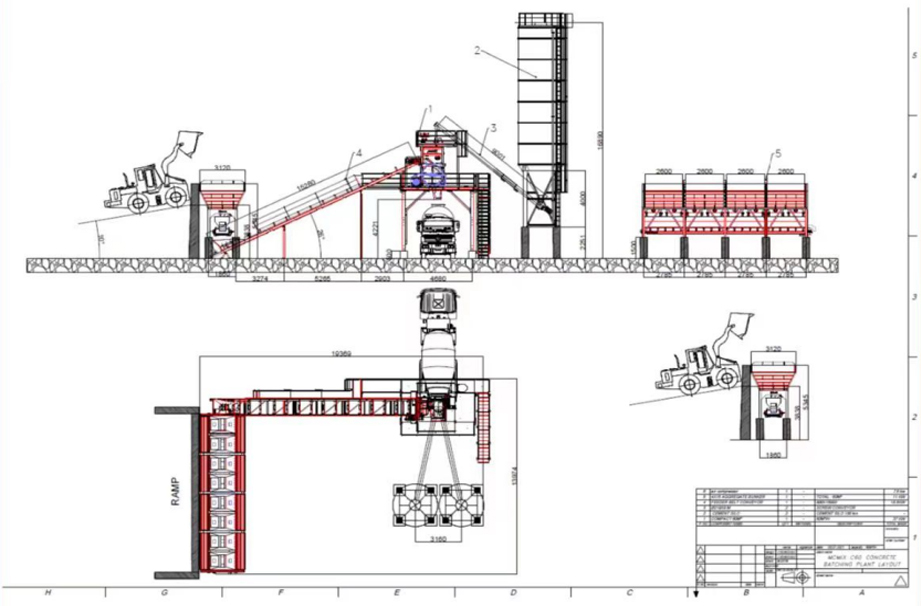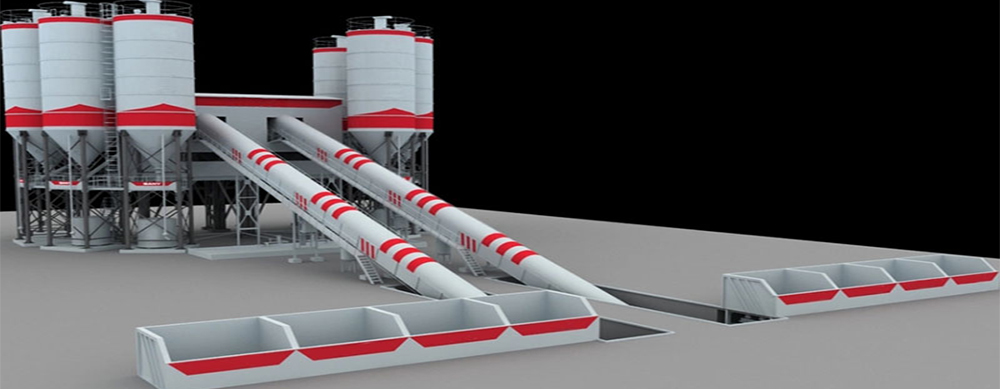An asphalt mixing plant is a crucial facility in road construction. It combines aggregates, such as sand and gravel, with asphalt binder to produce high-quality asphalt mixtures. The plant features a large drying drum that heats the aggregates to the required temperature. It has precise weighing systems for accurate proportioning of materials. With automated controls, operators can easily adjust mixing parameters. The layout is designed for efficient material flow, from storage bins to the mixer. High-capacity models can meet the demands of large-scale projects, ensuring a steady supply of asphalt for paving.
| content/type | LB-3000 |
| Rated productivity(t/h) | 180-240 |
| Mixing bar capacity(kg/batch) | 3000 |
| Total installed capacity (Finished product warehouse is not included)(kw) | 628 |
| Total floor area(m×m) | 50×38=1900 |
| Fuel consumption rate(kg/t) | ≤6.5 |
| Type of fuel | diesel fuel,heavy oil,natural gas |
| Finished material temperature(ºC) | 160 |
| Cumulative measurement accuracy of ore materials(%) | ≤±0.3 |
| Measurement accuracy of asphalt materials(%) | ≤±0.1 |
| Powder metering accuracy(%) | ≤±0.2 |
| Oil-stone ratio deviation(%) | ≤±0.1 |
| Stable and accurate discharge temperature(ºC) | ±5 |
| Ambient noise[dB(A)] | ≤80 |
| Noise in the operator's ears [dB(A)] | ≤70 |
| Dust removal method | Compartment, high-pressure pulse bag |
| Dust emission concentration[mg/Nm3] | ≤80 |

1. The frame of an asphalt mixing plant provides the structural support for the entire facility. It is usually made of heavy-duty steel to withstand the weight of various components and the dynamic forces during operation.
2. Storage Bins: These are large containers used to store different types of aggregates like sand, gravel, and crushed stone.
3. Conveyor Belts: Conveyor belts transport the aggregates from the storage bins to the next stage of the process.
4. Drying Drum: The drying drum is a crucial component. It rotates to tumble the aggregates and expose them to a hot air stream, which dries and heats the aggregates to the appropriate temperature.
5. Burner: The burner provides the heat source for the drying drum. It burns fuel, such as diesel, natural gas, or heavy oil, to produce a hot flame.
6. Weighing Hoppers: These are used to accurately measure the weight of each component that goes into the asphalt mixture.
7. Proportioning Equipment: Based on the desired mix design, the proportioning equipment controls the flow of materials into the mixer.
8. Mixer: The mixer is the heart of the asphalt mixing plant. It combines the heated and weighed aggregates, filler, and asphalt binder in a rotating drum or a pugmill-type mixer.
9. Storage Tanks: Asphalt storage tanks hold the finished asphalt mixture until it is loaded onto trucks for transportation to the construction site.
10. Loading System: The loading system consists of discharge gates or pumps that transfer the asphalt from the storage tanks to the transport trucks.

1. Project Scale: Determine the size and scope of your projects. For small-scale road repair or local paving jobs, a plant with a production capacity of 30-80 tons per hour might be sufficient.
2. Future Expansion: Think about the potential growth of your business or the increasing demands of future projects.
3. Drum-Mix vs. Pugmill-Mix: Drum-mix plants are known for their continuous mixing process and are generally more compact. They are suitable for projects that require a consistent output of asphalt mixtures.
4. Mixing Quality: Look for a plant with a well-designed mixing system that ensures thorough and uniform mixing of aggregates, filler, and asphalt.
5. Aggregate Storage Capacity: Ensure that the plant has sufficient storage for different types of aggregates. Adequate storage bins with proper discharge mechanisms can prevent production delays due to insufficient supply of aggregates.
6. Drying Efficiency: The drying drum's performance is crucial. Look for a plant with a drying drum that can effectively remove moisture from the aggregates to the desired level.
7. Weighing System Accuracy: The weighing hoppers and proportioning equipment must be highly accurate. High-precision load cells and advanced control systems are essential to ensure the correct proportion of aggregates, filler, and asphalt in the mixture.
8. Proportioning Flexibility: The plant should offer flexibility in adjusting the proportions of materials according to different mix designs.
9. Dust and Fume Control: An effective dust-collection system is necessary to minimize air pollution and maintain a healthy working environment.
10. Noise Reduction: Consider the noise level generated by the plant. Some plants have noise-reduction features like insulated enclosures around noisy components such as the drying drum and mixer.

The mixing system is the core of an asphalt mixing plant. It uses either a drum-mixing or pugmill-mixing process. In a drum-mix plant, the aggregates and asphalt are mixed as the drum rotates.
Many modern plants have adjustable mixing parameters. The operator can control the mixing speed, temperature, and the addition of additives such as anti-stripping agents or polymers.
The aggregate handling system consists of storage bins and conveyor belts. The storage bins have a large capacity to store different types of aggregates, such as sand, gravel, and crushed stone.
The drying drum is a key component for removing moisture from the aggregates. It rotates at a controlled speed to tumble the aggregates and expose them to a hot air stream.
Asphalt mixing plants are equipped with accurate weighing hoppers for aggregates, filler (like limestone powder), and asphalt.
The proportioning equipment controls the flow of materials into the mixer based on the set mix ratios. It can adjust the quantity of each material in real-time, allowing for flexibility in changing the mix design according to project requirements.
Modern asphalt mixing plants feature automated control systems. These systems can manage the entire production process, from the feeding of aggregates to the loading of the finished asphalt mixture.
Some advanced plants have intelligent features such as self-diagnosis and remote-monitoring capabilities. The self-diagnosis function can detect and alert operators to potential problems, reducing downtime.
